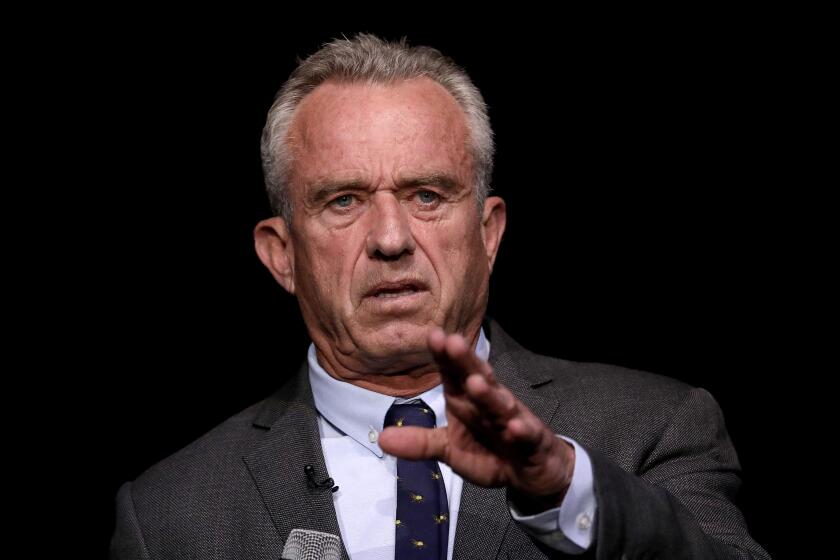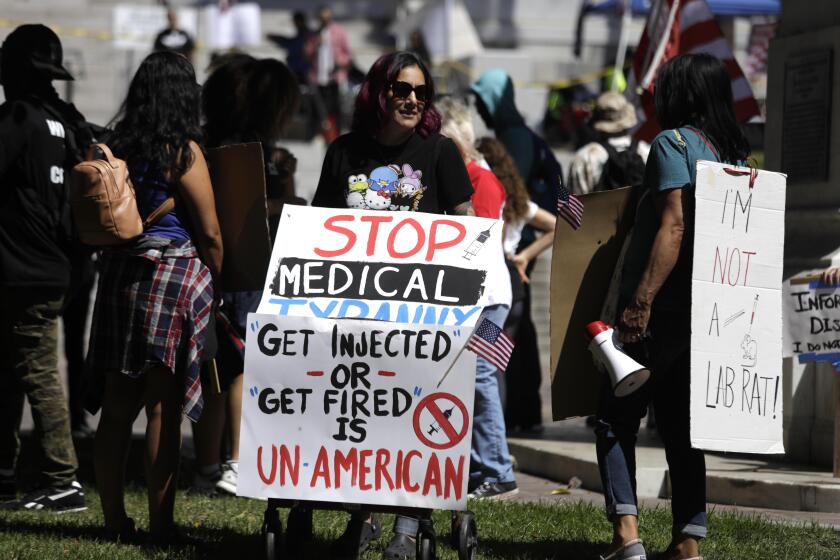Disinformation is a public health crisis. Here’s how scientists and doctors are fighting it

- Share via
In recent years, disinformation has seemed to be on an inexorable march across the scientific and medical landscape.
Prominent politicians, up to and including the former president, have promoted useless drugs as supposed cures for COVID-19. Partisan attacks on the safety and efficacy of COVID vaccines have expanded into attacks on all vaccines. Established scientific and medical authorities have been vilified on social media and on the airwaves and even been subjected to physical assault.
The sheer volume of lies and misrepresentations injected into the political mainstream has some scientists despairing of ever regaining the public’s attention.
“Scientists really recognize this as a problem, from what they see in the community and read in the news,” says Tara Kirk Sell of Johns Hopkins University’s Center for Health Security. “They see the problems they have from misinformation and disinformation on the public health side and in the medical field and in other areas. They want to figure out how to deal with it. We’re providing some guidance for combating it and making people more resistant to it.”
Florida Surgeon Gen. Dr. Joseph A. Ladapo is advising people to avoid the most effective COVID vaccines, just as a surge in disease cases gets worse.
Sell’s reference is to the “Practical Playbook for Addressing Health Misinformation” just released by her center. The 65-page publication amounts to a road map for identifying misinformation and disinformation and applying the best strategies for counteracting it before it spreads.
It’s part of an emerging genre of advice for scientists, public health officials and others who get confronted by rumors that interfere with their work, or by deliberate falsehoods; the latter is “disinformation,” as opposed to “misinformation,” which may simply be widely accepted misunderstandings that may have innocent sources.
Get the latest from Michael Hiltzik
Commentary on economics and more from a Pulitzer Prize winner.
You may occasionally receive promotional content from the Los Angeles Times.
UNICEF, the Yale Institute for Global Health and other organizations published one of the earliest such guides in late 2020, aimed specifically at anti-vaccine misinformation. Others have the broader goal of fighting conspiracy theories in general.
One recommendation that most seem to have in common is to take a strategic approach: Disinformation campaigns can’t be defeated by ad hoc measures; they require an organized, proactive and targeted approach mounted by credible defenders of science.
The effort is important because the disinformation has more than political consequences; it costs lives. Pseudoscience debunker Peter Hotez calculates that as many as 200,000 Americans may have perished from COVID after the vaccines were introduced because anti-vaccine propaganda dissuaded them from getting the shots.
Hiltzik: Measles is again on the march across the world, thanks to anti-vaxxers such as RFK Jr.
Measles cases are surging in Europe and Central Asia, according to the World Health Organization. Who’s responsible? The anti-vaccination movement and its leaders, such as Robert F. Kennedy Jr.
Cases of measles, which should have been eradicated in the U.S. years ago, are appearing again because of disinformation about the vaccines. The Centers for Disease Control and Prevention counts more than 20 measles cases so far this year in at least 11 states. That’s about one-third of the 58 cases recorded in all of last year, counted in only the first six weeks of 2024, suggesting that a more serious epidemic may loom on the horizon.
Six cases have occurred in a single school in Florida, a state whose Republican governor, Ron DeSantis, has placed anti-vaccine propaganda at the center of his public health policies. The school’s measles vaccination rate is about 89%, well below the 95% level thought to provide communal immunity protecting even the unvaccinated.
Scientists ... see the problems they have from misinformation and disinformation on the public health side, and in the medical field and in other areas. They want to figure out how to deal with it.
— Tara Kirk Sell, Johns Hopkins university
As I’ve reported before, the politicization of anti-COVID measures has turbocharged healthcare disinformation more generally. In part, the reason may be that the pandemic brought public health efforts out of the shadows.
“Often, public health has been an invisible force for good,” Sell told me. “People don’t really notice it because they don’t notice not getting sick and not getting food poisoning.” During the pandemic, however, “people saw public health acting in a more visible way, that made them aware, and sometimes a little bit scared, that sometimes public health measures can be restrictive.”
Sell acknowledges that the battle against disinformation has gotten harder. One reason is that more of it emanates from government sources.
That’s a novel issue. At a simulation exercise on pandemic responses that Sell’s institute hosted for business and public health officials in October 2019, one question that came up was: What if misinformation or disinformation comes from government?
The conclusion was “that’s a crazy question,” Sell told me. “Now, it doesn’t seem that crazy. We’ve seen a lot of it.”
Hiltzik: Scientists are paying a huge personal price in the lonely fight against anti-vaxxers
The anti-vaccination and anti-science movements are killing thousands of innocent people. Why don’t government agencies and professional groups speak up?
At a House hearing just last week, for instance, Rep. Marjorie Taylor Greene (R-Ga.) staged an attack on COVID vaccines consisting of misleading statistics presented out of context, unverified claims of side effects and flagrant misstatements about the consequences of COVID infection.
As I’ve reported, one of the nation’s most assiduous dispensers of anti-vaccine claptrap does so from an official perch. He’s Florida Surgeon General Joseph Ladapo, who was inserted into his post by DeSantis, who may be the nation’s second-most-dangerous official offender against good sense and sound public health policy.
Ladapo’s approach to the Florida measles outbreak, which includes downplaying the need for children to be vaccinated and allowing parents to make their own decision about sending even unvaccinated children to schools experiencing an outbreak, runs counter to recommendations from the CDC. The CDC places vaccination at the very top of its recommendations for preventing the disease and advises isolating those who may transmit the virus.
A problem of longer standing for anti-disinformation crusaders is encompassed in Brandolini’s Law, coined in 2013 by Alberto Brandolini, an Italian software engineer. Cleaned up, it states, “The amount of energy needed to refute [B.S.] is an order of magnitude bigger than that needed to produce it.”
To put it another way, disinformation peddlers need only make a claim that sounds plausible or might even have a small kernel of truth to influence the unwary. Debunking or refuting their assertions often requires offering nuanced or technical information that doesn’t have the same pizzazz.
Recognizing disinformation techniques and how they implant sticky but erroneous concepts in the minds of laypersons, Sell says, points to some useful rules of engagement. One is the value of “prebunking” — “addressing or refuting potential false information” before it’s widely disseminated, as the Johns Hopkins handbook puts it.
“People are not that creative,” she says. “They use the same stories over and over again with different health threats. You can expect that with any vaccination campaign there will be an infertility rumor, no matter what vaccine it is, or a rumor that a vaccine has been experimented on children. We see that every time. They work because they resonate” with target audiences — such as pregnant women or parents of small children.
“People need to be shown how to recognize disinformation tactics, such as an appeal to emotion” or personal stories of adverse side effects that are claimed to be representative of patients as a whole rather than rare occurrences.
How should we think about anti-vaccine activists who die from COVID?
It may also help to highlight the motivations of anti-science propagandists, who spread disinformation “often for social, political or financial gain.” Indeed, as the Washington Post recently documented from tax records, four nonprofit organizations that marketed medical misinformation during the pandemic saw their contributions leap by more than $100 million from 2020 to 2022.
Among them is Children’s Health Defense, the anti-vaccine group founded by Robert F. Kennedy Jr., who is currently trying to ride his anti-vaccine crusade to the Oval Office.
The lessons of the pandemic may help the public health community avoid some of the mistakes that allowed the disinformation lobby to undermine the public’s trust in scientists and medical experts, a crucial factor in its campaigns. The CDC and other public health agencies sometimes changed their recommendations on anti-COVID policies.
That was hardly an unexpected occurrence, since so little was known at first about the virus, its effects and the most suitable treatments. But it gave their adversaries the opening they needed to question the severity of the outbreak or the policy recommendations themselves, and to promote useless nostrums.
“Public health needs to be transparent about the reasons why advice is changing,” Sell says, “explaining that if you didn’t change with new evidence, you would be doing a disservice to the public. Maybe we didn’t do a good enough job in this pandemic in saying we’re going to learn more, and our advice may change. And we’ll do our best to keep you as informed as possible as that advice changes.”
The challenge of fighting the fire hose of falsity being trained on science has made some scientists cynical about the prospects of victory, Sell acknowledges. “The Playbook is not a silver bullet,” she says. “But it helps. There are things to be done, and we can’t give up. Attacking misinformation in as many different ways as possible is something we’re going to have to do.”
More to Read
Inside the business of entertainment
The Wide Shot brings you news, analysis and insights on everything from streaming wars to production — and what it all means for the future.
You may occasionally receive promotional content from the Los Angeles Times.














